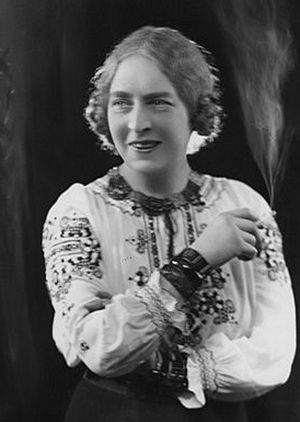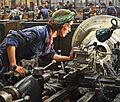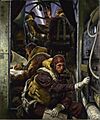Laura Knight facts for kids
Quick facts for kids
Laura Knight
|
|
|---|---|

Dame Laura Knight circa 1910
|
|
| Born |
Laura Johnson
4 August 1877 Long Eaton, Derbyshire, England
|
| Died | 7 July 1970 (aged 92) London, England
|
| Education | Nottingham School of Art |
| Known for | Painting |
|
Notable work
|
The Nuremberg Trial (1946) |
| Movement | Impressionism |
| Spouse(s) |
Harold Knight
(m. 1903; died 1961) |
| Awards | Silver Medal at the 1928 Amsterdam Art Olympics |
Dame Laura Knight (born Laura Johnson; 4 August 1877 – 7 July 1970) was a famous English artist. She used many different art styles, like oil painting, watercolors, and etching. Laura Knight was known for painting real-life scenes and people. She became one of Britain's most successful artists.
Laura Knight helped open doors for other women artists. In 1929, she was given the title of Dame. In 1936, she became the second woman ever elected to the Royal Academy. This was a very important art group. She loved painting scenes from the theatre and ballet. During World War II, she worked as a war artist. She also found inspiration in people often overlooked, like Romani people and circus performers.
Biography
Early Life and Art School
Laura Johnson was born in Long Eaton, England, in 1877. Her father left the family when she was young. This meant her family often struggled with money. When she was 12, she was sent to France to live with relatives. The idea was for her to study art in Paris. But her relatives also faced money problems, so Laura had to return to England.
Laura's mother taught art at the Nottingham School of Art. She helped Laura get into the school for free when Laura was just 13. At 15, Laura even took over her mother's teaching duties when her mother became very ill. Laura later won a scholarship and a gold medal in a big student art competition. She met another promising art student, Harold Knight, and they became good friends. They married in 1903.
Life in Fishing Villages and Abroad
In 1894, Laura and Harold visited Staithes, a fishing village in Yorkshire. They loved it so much they moved there. Laura painted the local people, showing their daily lives and struggles. She often used soft, dark colors because she didn't have much money for expensive paints. Painting children in the village helped her get better at drawing people.
Laura and Harold Knight traveled to the Netherlands in 1904 and 1905. They visited an artists' community in Laren. This community was known for painting rural scenes. These trips helped them explore new artistic ideas.
Painting in Cornwall
In 1907, the Knights moved to Cornwall, a beautiful coastal area. They joined a group of artists known as the Newlyn School. Laura's art became more colorful and lively here. She started painting outdoors, capturing scenes in natural light. This style is called plein-air.
One of her famous paintings from this time was The Beach (1909). It showed children playing in bright sunlight. Another work, Daughters of the Sun (1911), showed women by the sea. Sadly, this painting was badly damaged later on. Her painting The Green Feather (1913) was bought by the National Gallery of Canada.
During World War I
During the First World War, there were rules about sketching near the British coast. This made it hard for Laura to paint her usual landscapes. She got special permits to continue her work. Some of her paintings from this time showed a lone woman by the sea, hinting at the war's darker mood.
In 1916, Laura was asked to paint for the Canadian government. She created paintings about physical training in army camps and boxing matches. Her husband, Harold, refused to fight in the war. He was made to work as a farm laborer instead.
Ballet and Etching
From 1911 to 1929, Laura Knight spent time backstage at ballets in London. She drew and painted famous dancers like Anna Pavlova. She captured their movements and the atmosphere behind the scenes.
In the early 1920s, Laura started making etchings. This is a type of printmaking. She made many prints, including posters for London Transport. She continued to create posters throughout her career, even one about circus clowns.
Painting in Baltimore
In 1926, Laura joined Harold in Baltimore, USA. He was painting portraits of surgeons. Laura got permission to paint in children's hospitals. She also painted in the black wards of a hospital that was segregated by race. She painted a nurse named Pearl Johnson, who introduced her to the early American civil rights movement. Laura painted portraits of women that looked very modern for their time.
Circus Life
Laura Knight loved the circus! In the 1920s, she started visiting the Bertram Mills Circus in London. She painted many of the performers, like clowns and acrobats. Painting in the busy circus meant she had to work very fast. Her large painting Charivari or The Grand Parade (1929) showed almost everyone in the circus.
She toured Britain with the circus in 1929 and 1930. Her paintings of small groups of clowns were especially good. She also painted everyday scenes, like homes and London streets. Some of her circus designs were even used for chocolate box designs and tableware.
Achievements and Awards
Laura Knight received many honors for her art. In 1928, she won a Silver Medal in painting at the Amsterdam Art Olympics. In 1929, she was made a Dame Commander of the Order of the British Empire. This is a very high honor in Britain. In 1936, she became the first woman in almost 200 years to be a full member of the Royal Academy.
She also wrote her first autobiography, Oil Paint and Grease Paint, in 1936. It became a best-selling book. Laura and Harold often visited Malvern, Worcestershire, where she painted a portrait of the famous writer George Bernard Shaw.
Painting Romani People
In the mid-1930s, Laura Knight became friends with groups of Romani people (Gypsies) at horse races. She often painted them from her large antique Rolls-Royce car. She visited a Romani settlement in Buckinghamshire for several months. These visits led to powerful portraits, like Old Gypsy Women (1938) and Gypsy Splendour (1939).
World War II Artist
When World War II began in 1939, Laura Knight became an official war artist. She was hired by the government to create paintings that supported the war effort.
Some of her important war paintings include:
- Corporal J. D. M. Pearson, GC, WAAF (1940): This painting shows a brave woman from the Women's Auxiliary Air Force (WAAF).
- In For Repairs (1941): This shows WAAF members repairing a large barrage balloon.
- A Balloon Site, Coventry (1943): This painting shows women working together to raise a barrage balloon. It was used to encourage more women to join the Balloon Command.
- Ruby Loftus Screwing a Breech-ring (1943): This famous painting shows a woman working in a factory. It was used to encourage women to work in war factories. It was shown in newspapers and even a short film!
- Take Off (1944): This large painting shows the crew of a bomber plane getting ready for a flight. Laura Knight lived on the air base to paint this detailed scene.
Laura Knight created many paintings during the war. Most were shown in famous galleries to boost public morale.
Nuremberg Trials
After the war, Laura Knight suggested painting the Nuremberg trials. These were trials where Nazi war criminals were judged. She went to Germany in 1946 and spent three months watching the trial.
Her painting, The Nuremberg Trial, is very powerful. It shows the Nazi criminals in the courtroom. But behind them, the walls are missing, revealing a ruined city on fire. Laura explained that she wanted to show the death and destruction that was still everywhere in the city.
Later Years
After the war, Laura Knight continued to paint her favorite subjects: ballet, circus, and Romani people. She kept exhibiting her work every year. In 1961, her husband Harold died after 58 years of marriage.
In 1965, Laura published her second autobiography, The Magic of a Line. The Royal Academy held a huge exhibition of her work that year. It was the first time they had ever held such a big show for a woman artist. Laura Knight died on 7 July 1970, at the age of 92.
Published Works
- 1921: Twenty-one Drawings of the Russian Ballet
- 1923: Laura Knight: A Book of Drawings
- 1936: Oil Paint and Grease Paint
- 1962: A Proper Circus Omie
- 1965: The Magic of a Line
Membership
Laura Knight was part of many important art groups:
|
|
Exhibitions
Here are some places where Laura Knight's art was shown during her life:
- 1901: Royal Institute of Oil Painters
- 1903: Royal Academy Summer Exhibition (and regularly from 1909)
- 1906: Dutch Life and Landscape, Leicester Galleries
- 1907: Life and Landscape, Leicester Galleries
- 1910: Venice Biennale (also 1914, 1924)
- 1912: Leicester Galleries (also 1926, 1928, 1932, 1934, 1939)
- 1912: Carnegie International, Pittsburg (also 1914, 1922)
- 1915: Fine Art Society
- 1918: Camp Life and Other Paintings, Leicester Galleries
- 1920: Pictures of the Russian Ballet, Leicester Galleries
- 1920: Pictures of Modern Artists, Manchester City Art Gallery
- 1922: Alpine Club Galleries
- 1930: Circus Folk, Alpine Club Galleries
- 1931: Usher Gallery, Lincoln
- 1931: Art Gallery of Ontario, Toronto
- 1933: Laing Art Gallery, Newcastle upon Tyne
- 1934: Nottingham Castle Museum
- 1963: Upper Grosvenor Galleries (also 1968, 1969)
- 1965: Diploma Galleries, Royal Academy
Exhibitions After Her Death
- 1970: Nottingham Castle Museum
- 1983: Edition Graphique Gallery, London
- 1985: Painting in Newlyn 1900–1930, Newlyn Art Gallery
- 1988: David Messum Fine Art
- 1989: Nottingham Castle Museum
- 1991: David Messum Fine Art
- 1996: Women Artists in Cornwall 1880–1940, Falmouth Art Gallery
- 2005: Painting at the Edge, Penlee House Gallery
- 2006: From Victorian to Modern..., Djanogly Art Gallery
- 2008: Laura Knight at the Theatre, The Lowry
- 2008: The Magic of a Line: Drawings by Dame Laura Knight, R.A., Royal Academy of Arts
- 2012: Laura Knight: In the Open Air, Penlee House Gallery
- 2013: Laura Knight Portraits, National Portrait Gallery, London
- 2021: Laura Knight: A Panoramic View, Milton Keynes Gallery
Images for kids
-
Land Army Girl (1944) (National Archives)
See also
 In Spanish: Laura Knight para niños
In Spanish: Laura Knight para niños







